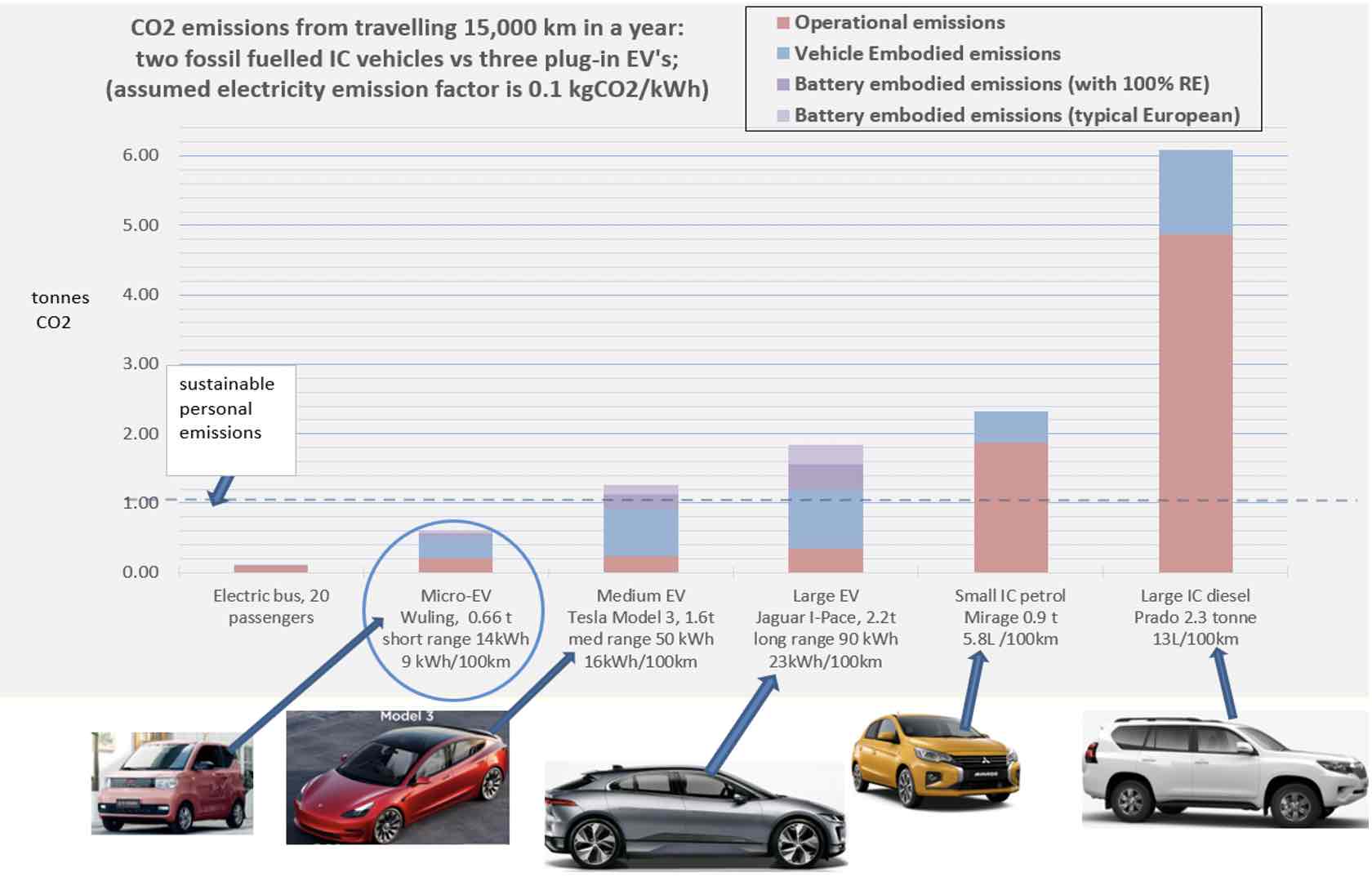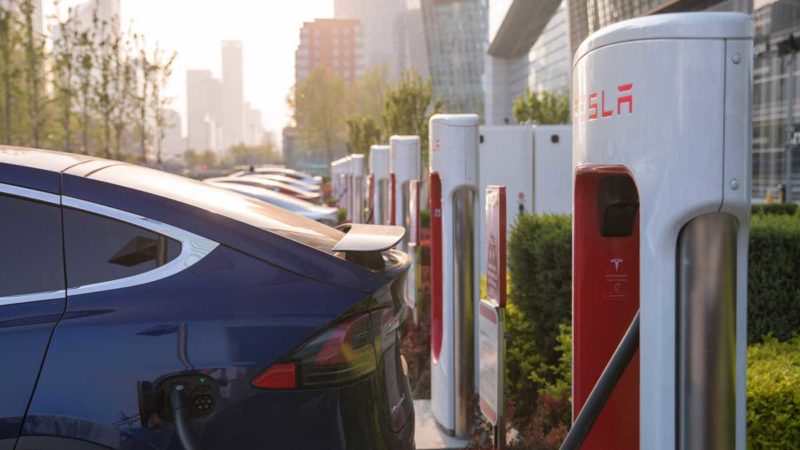For the past 70 years we have assumed we can all have personal cars to move around in and there is not even a limit on what size they can be. There is a lot of hype these days about big, fast electric cars (EV’s). Will switching our existing fuelled vehicles to similar sized EV’s enable us get to ‘net zero carbon emissions’?
Figure 1. below shows that the answer is probably no.
Even with near zero emissions electricity, the embodied emissions of the one to three tonne vehicles we are used to driving is too high. Even if powered and manufactured using clean electricity, a typical medium range EV (Tesla Model 3) incurs more than the total per capita emissions allowable to achieve net zero emissions globally.
Figure 1

Current world carbon emissions are about 36 million tCO2e (tonnes CO2 equivalent) and have not yet peaked. These emissions are primarily caused by the 1.5 billion or so of us who drive cars, eat red meat, fly and use advanced built infrastructure. The figure is rising as more people attain their aspirations.
Earth’s vegetation and oceans can take up about 55% of this carbon; i.e., atmospheric CO2 would stay the same if human-made emissions were reduced by 45% and slowly go down if they were reduced further to zero.
In this analysis I assume carbon emissions are reduced to 50%*36 billion = 18 billion tonnes per year, preventing further global warming.
Dividing by the current world population of 7.9 billion means we can each emit 2.28 tCO2e per year per person from all sources. People in some developing nations already emit less than that. The following graphic assumes that only about 50% of that amount – 1.1 t – can come from personal sources i.e., the things we consume personally and have discretion over. The other half comes from industries and public/corporate infrastructure and buildings.
Note: You can estimate your own carbon footprint by downloading my calculator here.
Vehicle operational emissions
Operational emissions of IC vehicles are simply calculated from the emissions factor (EF) of the fuels. Electricity is assumed to be 90% from renewable sources, with an EF is 0.1 kg CO2e per kWh. This is achievable and cost effective with current technologies.
Vehicle embodied emissions
Embodied emissions from manufacture and maintenance of fuelled vehicles is about 8 tCO2e per tonne of vehicle weight and equates to about 25% of the life cycle emissions of fuelled vehicles. Over 75% are incurred in the mining, processing and smelting of materials. I have assumed that the steel and other metal and plastic components are made using fossil fuels.
Steel making with ‘green’ hydrogen is only just beginning to be commercialized and it will take decades to convert all production. Injecting hydrogen into existing furnaces can reduce emissions by up to 24% .
Up to 97% reduction in carbon emissions is theoretically possible with a new steel making process utilizing only green hydrogen. All smelters would have to be replaced with the new technology and zero emission electricity equivalent to 25% of existing world capacity would have to be built to supply the hydrogen for steel making alone.
Embodied emissions of batteries
Emissions intensity of battery manufacture is high; nearly half is attributable to electric drying chambers. Mining and processing of lithium, aluminium, nickel and copper is the other main component. Estimates range from 150 kg CO2e/ MWh (plants in Asia), 106 in modern European plants down to a theoretical 61 using near zero emissions electricity.
A long range 90 kWh battery weighing 585kg manufactured in Europe today would incur 9.5 t CO2e, an emission intensity of 16 t CO2e / kg battery weight (up to 50% higher if manufactured in Asia).
Why and how our transport needs to change
Atmosphere and oceans are ‘global commons’, essential to all humanity. The scientific consensus says we must achieve ‘net zero carbon by 2050’ if we are to keep the planet liveable for humans. Therefore, we must all aim for the same personal carbon emissions limit of a bit over 1 tonne per year.
It is the big consumers (which includes us) who are the big emitters – typically 12 tCO2e each per year, compared to less than 2t for poorer less developed populations – so we have the most reducing to do. We only have 29 years to do it (the lifetime of some cars), which means we need to start changing our transport choices now.
Fuel burned by road vehicles, planes, ships and trains comprises 16% of global emissions; private vehicles account for about half of this. Upstream and fugitive fuel emissions add 3-4% more and transport infrastructure several percent on top of that.
Embodied emissions of vehicles adds at least 4%, meaning that the total carbon emissions attributable to transport are at least 25% of the world total. Road vehicles in particular are generally used very inefficiently, with large cars and trucks used to carry small loads.
In our increasingly carbon constrained world we cannot go on driving 1- 3 tonne vehicles with one or two occupants. We need to travel more by public transport, walking and cycling. Micro EV’s can have a role provided they are shared. I posit that in addition to being electrified, personal vehicles should weigh no more than 250 kg per passenger carried.
I am aged 68 and don’t own a car, having already made the change to electric motorcycles. My 20 kW Vectrix weighs 220kg and regularly carries two riders at up to 110 kph and has a range of 80 km.
I had a smaller 4 kW machine, which could also carry a pillion passenger at up to 70 kph and weighed 120 kg. My e-bicycle, weighing a mere 22 kg can carry the rider at average speeds of 23 kph with a range of 60 km.
Emissions of E-bikes are even less than electric buses. Stowed beneath a road bus, it provides clean destination transport for sustainable holidays with the added bonus of exercise for health!

Not everyone is willing and able to ride bikes, but there are ‘micro’ EV’s like the Wuling Macaron in Figure 2 above that can carry 2 adults and 2 children, weighs 660 kg (similar to the 1970’s Honda Z series) and has a range of 150 km and top speed of 100 kph. One of these shared by two people would be a sustainable option for 80% of the kilometres travelled by most urban dwellers.
What about EV’s of the size we drive now? Even the smaller models can only be sustainable if they are powered with clean electricity and all seats are occupied at all times. For example, 5 seater plug-in EV’s like the Nissan Leaf and Ioniq hybrid need to be carrying at least 4 people. Car occupancy in Australia averages less than 1.3. The cars most of us own are clearly not sustainable for personal transport.
E-people movers, (e.g. BYD E6 , available in Australia next year) are appropriate for hire vehicles, taxis and expedition vehicles that are mainly used fully loaded. Their larger size enables more seats, bigger batteries and longer range, making them suitable for groups or families to hire for long trips.
Electric buses and trains are of course the lowest emission transport options. They are also the safest, potentially most comfortable and provide time to read and rest.
In summary I see the future of transport for urban dwellers as all electric – train, bus, own a micro-vehicle and hire a larger vehicle only when there is no other option.
Slightly less travel convenience and speed are a small price to pay for a liveable planet for our grandchildren.


